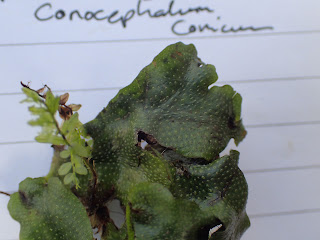15th January 2022
The fungus study group don't usually hold a field meeting during January but were convinced to do so this year. This proved to be both a popular and productive decision, with around 30 members meeting up and recording around 120 species. As you would expect for the time of year much of these were either growing on wood or were microfungi on plants, but there were interesting examples of each. It looks like at least two of my finds turned out to be new for Norfolk - a young specimen of an oysterling with brown hair tufts on the cap was Scaly Oysterling (Crepidotus calolepis) and some small clear wart-like growths on Exidia plana were the mycoparasitic fungus Heteromycophaga glandulosae, whilst some small cocoa-bean like growths on an Ash branch were Hysterographium fraxini were also of note.
At a foray last year Stewart Wright had introduced us to the tiny black 'sundial' like projections under Alder leaves caused by Ophiognomonia alni-viridis. After he found the related species Gnomonia gnomon on Hazel leaves I asked if there were any others we should be looking for, and we managed another two - Ophiognomonia setacea on Oak and O. intermedia on Silver Birch. There is also a rare/under-recorded one on dead Rose leaves for me to look for elsewhere.
Foxley is an excellent reserve for many groups of species, and Rob Yaxley kindly pointed out some bryophytes as we went round, including the liverwort Conocephalum conicum and Big Shaggy-moss Rhytidiadelphus triquestris. Rob also identified a millipede that I'd spotted underneath a fallen branch as Brachydesmus superus.
New macro moths are always a bonus, and having seen a rather tatty specimen on the ground I was pleased when someone found a fresher looking Spring Usher. There was a new micro moth species too, when Stewart found an occupied leaf mine in Greater Stitchwort containing the larva of Three-colour Groundling, Caryocolum tricolorella. The light was beginning to fade as we walked back to the cars, allowing several group members to use their UV torches to illustrate the luminescence of Sulphur Tuft.













No comments:
Post a Comment